Why Do We Celebrate Halloween?

Halloween 2024- The Holiday’s Origin and Traditions
Halloween, with its eerie ambiance, creative costumes, and the iconic tradition of trick-or-treating, is a holiday that many eagerly anticipate each year. But beyond the fun and festivities, have you ever wondered where Halloween comes from? How did Halloween originate, and why is Halloween celebrated the way it is today? Let’s delve into the origins of Halloween and explore the fascinating history behind some of its most popular traditions.

The Origins of Halloween
The origin of Halloween dates back over 2,000 years to the ancient Celtic festival of Samhain (a Gaelic word pronounced “SAH-win”), which marked the end of the harvest season and the beginning of winter, a time associated with death. On the night of October 31st, the Celts believed the boundary between the living and the dead blurred, and spirits could roam the earth. To ward off these spirits, the Celts would light bonfires and wear costumes, a tradition that laid the groundwork for the modern Halloween celebrations.
As Christianity spread through Celtic lands, the church aimed to replace pagan festivals with Christian holidays. In the 8th century, Pope Gregory III designated November 1st as All Saints' Day, and the night before became known as All Hallows' Eve, eventually evolving into Halloween. This blend of ancient Celtic rituals, Roman customs, and Christian influences shaped Halloween into the celebration we recognize today.
Popular Halloween Traditions and Their Origins
Halloween is filled with various traditions, each with its own unique history. Here are some of the most beloved Halloween customs and the fascinating stories behind them:
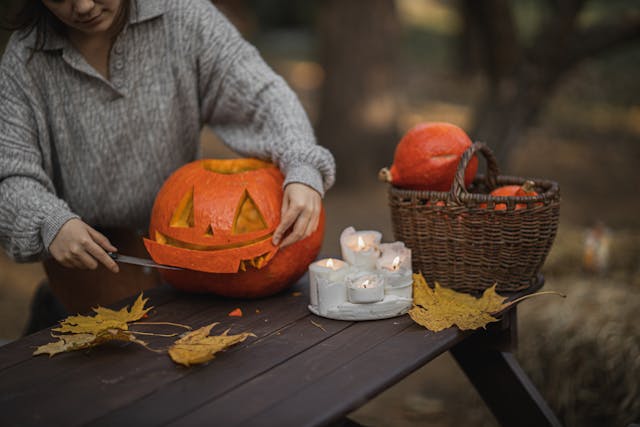
Carving Jack-o’-Lanterns
Carving Jack-o’-Lanterns is a quintessential Halloween activity, where people create spooky faces on pumpkins and light them from within. The tradition of carving Jack-o’-Lanterns originated in Ireland, where people used turnips instead of pumpkins.
This custom is linked to the legend of Stingy Jack, a man who repeatedly tricked the Devil and was cursed to wander the earth as a ghost. The Devil gave Jack a burning lump of coal, which he placed inside a carved-out turnip to light his way. To ward off evil spirits, locals began carving scary faces into turnips, a practice that evolved into the pumpkin-carving tradition we enjoy today.
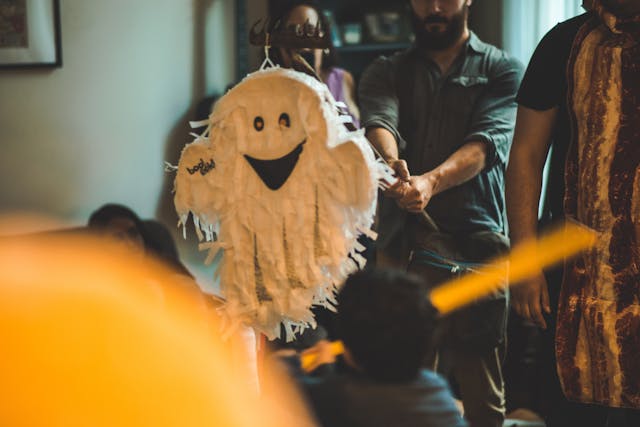
Seeing Ghosts
Ghosts are a common theme during Halloween, with decorations and costumes often featuring these spectral figures. The belief in ghosts on Halloween dates back to the Celtic festival of Samhain.
During this festival, the Celts believed that spirits of the dead could return to the earth, leading to encounters between the living and the dead. When Christian missionaries introduced “All Souls’ Day” on November 2nd, the idea of the living coming into contact with the dead around this time of year continued, perpetuating the association of Halloween with ghosts.
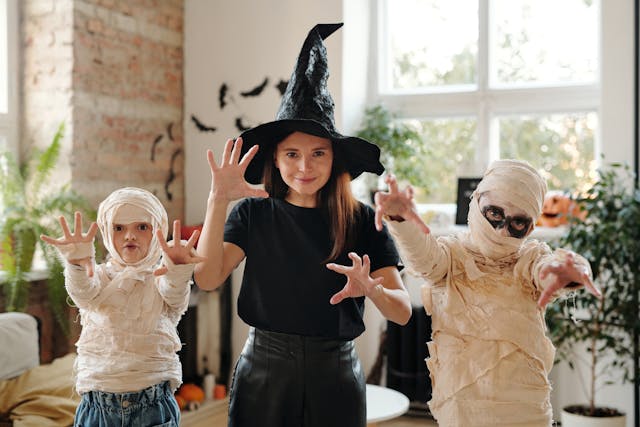
Wearing Scary Costumes
Dressing up in costumes is one of the most popular Halloween activities, allowing people to embody everything from scary monsters to beloved characters. The tradition of wearing costumes on Halloween also originates from the Celtic festival of Samhain.
To avoid being recognized and terrorized by wandering spirits, the Celts would put on disguises to confuse the spirits and be left alone. This practice evolved into the modern tradition of dressing up, where people embrace their creativity and enjoy the thrill of transformation.
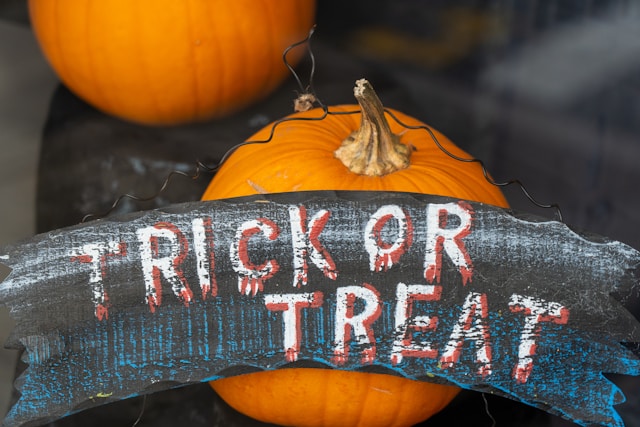
Trick-or-Treating
Children dress up in costumes and go door-to-door in their neighborhoods, collecting candy by saying, “Trick or treat!” The origins of trick-or-treating are debated, but there are several theories:
- One theory links it to the Celtic practice of leaving food out to appease spirits during Samhain.
- Another theory connects it to the medieval practice of "souling," where the poor would go door-to-door on All Souls’ Day, offering prayers for the dead in exchange for food.
- A third theory suggests that modern trick-or-treating evolved from the German-American tradition of "belsnickeling," where children would dress in costumes and ask neighbors for treats.
Regardless of its origins, trick-or-treating has become a beloved part of Halloween festivities.

Bobbing for Apples
Bobbing for apples is a traditional Halloween game where participants try to catch apples floating in water using only their teeth. The game of bobbing for apples traces back to a Roman festival honoring Pomona, the goddess of agriculture and abundance.
During this festival, the game was part of a courting ritual, where young men and women would try to predict their future relationships. When the Romans conquered the British Isles, this festival merged with the Celtic Samhain, and the game became a popular Halloween activity.
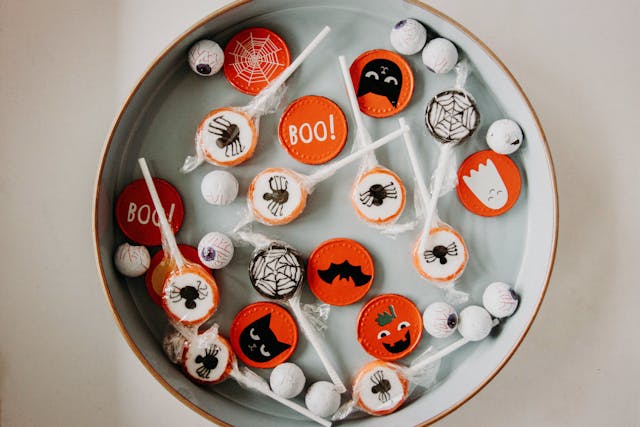
Additional Halloween Traditions and Their Origins
Halloween is filled with other fascinating traditions, each with a rich history:
- Black Cats: The superstition around black cats stems from the Middle Ages when they were considered symbols of the Devil. This belief was reinforced during the witch trials, as black cats were often associated with witches and thought to be their supernatural companions.
- Black and Orange Colors: The traditional Halloween colors of black and orange have roots in the Celtic festival of Samhain. Black symbolized the death of summer, while orange represented the autumn harvest.
- Candy Corn: Originally called “Chicken Feed,” candy corn was created in the 1880s and became associated with Halloween due to its corn shape, which linked it to the harvest season.
- Pranking: Mischief and pranks have long been associated with Halloween, particularly through the tradition of “Devil’s Night,” where light-hearted mischief was part of the festivities, a practice that continues in various forms today.
- Lighting Candles and Bonfires: During Samhain, Celts lit bonfires to guide spirits to the afterlife. This tradition evolved into lighting candles, which are now used to create a spooky atmosphere during Halloween.
- Candy Apples: Candy apples became a popular Halloween treat in the early 1900s, initially invented by a candymaker who was experimenting with red cinnamon candy. Their association with Halloween grew due to their connection with the harvest and the Roman festival of Pomona.
- Bats: Bats have been linked to Halloween since the earliest celebrations of Samhain, where bonfires would attract insects, and in turn, bats. Over time, bats became associated with the supernatural and Halloween’s eerie atmosphere.

Enhancing Your Halloween Celebration with TableclothsFactory
To fully embrace the spirit of Halloween, it's essential to create an environment that reflects the holiday’s eerie charm. TableclothsFactory offers a wide range of products so you could incorporate spooky elements into your Halloween celebrations:
- Spooky Table Settings: Use black lace tablecloths or spider web overlays to create a gothic, haunted look for your dinner table.
- Pumpkin Décor: Adorn your home with artificial pumpkins in various sizes and colors, perfect for creating a festive yet mess-free ambiance.
- Atmospheric Lighting: Set the mood with flickering LED candles and string lights to give your space a ghostly glow.
- Themed Dinnerware: Add Halloween-themed plates, cups, and napkins featuring bats, skulls, or other spooky motifs to your table setting.
- DIY Centerpieces: Create eerie centerpieces using faux flowers in dark, moody shades, accented with Halloween-themed accessories like plastic spiders or cobwebs.
Frequently Asked Questions About Halloween Origins
1. What is the origin of Halloween?
Halloween originated from the Celtic festival of Samhain, where people believed the boundary between the living and the dead blurred on October 31st. Over time, it evolved with Roman and Christian influences into the modern holiday.
2. How did Halloween start?
Halloween began as part of the Celtic Samhain festival, where people lit bonfires and wore costumes to ward off spirits. It later merged with Christian traditions to become Halloween.
3. Why do we celebrate Halloween on October 31st?
Halloween is celebrated on October 31st because it coincides with the Celtic festival of Samhain, a time when spirits were believed to roam the earth.
4. What does Halloween celebrate?
Halloween celebrates a mix of ancient rituals and modern customs, including honoring the dead and enjoying festive activities like dressing up, trick-or-treating, and carving pumpkins.
5. Where did the tradition of carving pumpkins come from?
The tradition of carving pumpkins originated in Ireland, where people initially carved turnips based on the legend of Stingy Jack. When Irish immigrants came to America, they began using pumpkins instead.

Written by Zora Williams
Zora Williams is an event decorator and writer with 4 years of experience in the event styling industry. After studying Art and Design at her local community college, she began her career as an assistant at a boutique event company specializing in milestone celebrations.
